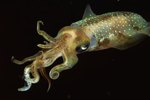
Poisonous cone snails of North America are predatory carnivores living in tidal waters from California to Florida. They're found under rocks in coral reefs and in mangroves. All cone snails are poisonous, and some can be deadly, but North American cone snails are not fatal to humans. Scientists are studying cone snail venom, which has the potential for relieving pain and treating diseases.
Physical Characteristics
The cone snail has a siphon tube on top of his head, which serves as a nose, detecting prey that's close by. The proboscis is a flexible tube that's twice as long as his body, and it delivers venom produced by a gland inside the snail's body. He has a huge mouth that reaches out to engulf prey. The cone snail has two eyes on each side, located on stalks beside his mouth.
Cone Snail Shells
All cone snail shells are cone-shaped, but they're found in a wide variety of colors, patterns and designs. They can be large or small, slender or broad. The shell's top can be flat, round or pointed, and the shoulder can be rounded, sloped or squared. The texture varies from smooth to corded, grooved or knobby. Most cone snail shells are vividly colored with interesting patterns, but some are muted tan or gray without patterns.
Feeding Habits
Cone snails are nocturnal hunters, using their long proboscis to lure fish, worms and other snails. They inject fast-acting poison with a toothed ribbon connected to the venom gland, called the radula, paralyzing their prey. Cone snails often burrow in underwater sand, leaving their siphon tube exposed to detect prey. They can consume prey as large as themselves, which may take a few days to digest. They remain buried until the food is digested.
Medical Research
Scientists began studying cone snail venom in the 1990s. Prialt, a synthetic pain medication, is a result of these studies. It relieves severe and chronic pain, is more potent than morphine, and has no risk of addiction. Scientists believe medicines made from cone snail conotoxins have the potential to be used in treatments for epilepsy, Parkinson's disease, strokes, cancers and other painful diseases.
References
Photo Credits
-
Jupiterimages/Photos.com/Getty Images
Writer Bio
Karen Mihaylo has been a writer since 2009. She has been a professional dog groomer since 1982 and is certified in canine massage therapy. Mihaylo holds an associate degree in human services from Delaware Technical and Community College.




